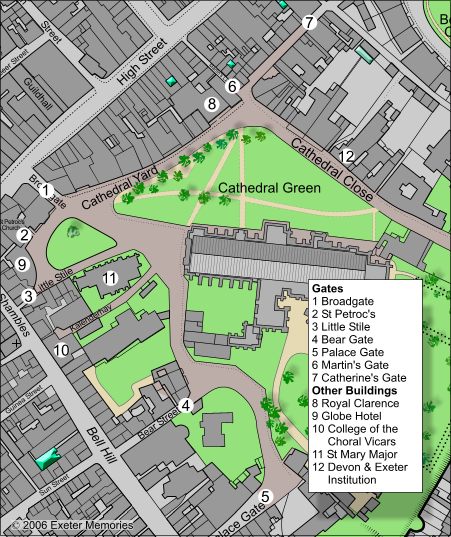 The area of the Cathedral Close
has been the heart of Exeter since the Romans first built their bath
house, and basilica, in the First and Second Centuries. The earliest
Christian burials date from the fifth century, and the church was well
established by 680 when a young lad from Crediton came to the newly
built minster for his education. The young man became St Boniface,
credited for his work in turning Germans towards Christianity. The area of the Cathedral Close
has been the heart of Exeter since the Romans first built their bath
house, and basilica, in the First and Second Centuries. The earliest
Christian burials date from the fifth century, and the church was well
established by 680 when a young lad from Crediton came to the newly
built minster for his education. The young man became St Boniface,
credited for his work in turning Germans towards Christianity.
Leofric,
Bishop of Devon and Cornwall, who was based in Crediton, obtained
permission to move to the walled city of Exeter, as his seat was at
risk of marauding Danish raiders. He arrived in 1050 and worked to
improve an impoverished church in the city, surviving the Norman
invasion, and even helping towards a smooth transition to Norman rule.
During the great Norman, building age, a patch of land to the east of
the old minster became the focus for a new Cathedral.
Work was
started in 1114 by Bishop Warelwast, and by 1200, despite several
setbacks, the two great towers were complete. A period of rebuilding
and improvement commenced in 1270, turning the Cathedral Yard into a
massive building site, and a magnet for every vagrant around.
The Yard is Walled
After the murder of Walter
Lechlade in 1283, Bishop Quinell obtained
permission, from Edward I, to build a wall around Cathedral Yard with
seven gates, that could be locked at night. It was this single act that
delineated the boundary of church authority over the secular within Exeter.
By 1637, the churchyard was becoming overcrowded from burials, as the ground level had risen to just below the cathedral windows. Bartholomews Yard was
opened in November of the same year, while the Cathedral Yard closed
for new interments. The first book, entitled Good Thoughts in Bad Times,
to be printed in the city was printed by Thomas Hart in 1645
in St Peter's Yard; this was on a travelling press, which no
doubt saw service during the Civil
War, printing propaganda pamphlets. One of the earliest
newspapers in the country, the Exeter Mercury, was first printed by
Philip Bishop, also in St Peter's Yard, in 1714. In November 1703, a
great storm swept the south-west, uprooting many of the large elms in
Cathedral Yard. The limes that replaced them did not thrive, so more,
young elms were planted, some of which survived into the twentieth
century.
The Assembly Rooms, built in 1769 by William Mackworth Praed became
England's first hotel in 1770, and still exist in the shape of the Royal Clarence Hotel.
The great improvements of the early nineteenth century did not bypass
the buildings around Cathedral Yard - in 1825 the old Broadgate was
demolished and the building now housing Pizza Express, but better known
as Tinleys, was constructed. The Courtenay's town house became the Devon
& Exeter Institution in 1813, while Mol's Coffee House was
occupied by John
Gendall in 1834, the first to use the premises as an artists
gallery. The space was also used for the annual Saturnalia or November 5th bonfire,
when city folk would celebrate the thwarting of Guy Fawkes, and burn
effigies of the Pope, William Booth and others, whom they thought
religiously subversive. Riots would often ensue and the practice banned
towards the end of the nineteenth century, not only to preserve public
safety, but to safeguard the west side of the Cathedral from heat
damage.
Most of the buildings around the Close survived damage in the 1942
blitz, although the Globe
Hotel was lost to fire and the house where John Simcoe,
the first Governor of Canada died, was totally destroyed. The latter
has been faithfully rebuilt, and only a trained observer would know the
difference. In 1971, St Mary
Major Church, on the site of the old Minster was demolished.
While the foundations were excavated, Saxon burials were discovered,
and beneath these remains, a Roman
bath house. After a thorough investigation by archaeologists,
the site was covered with sand and grassed over.
Cathedral Yard and Close are, for the most part, now a tranquil haven
in an expanding city. Popular with tourist and local alike, there is no
better way of passing half an hour, than sitting in the Close and
contemplating two thousand years of human history and events.
|
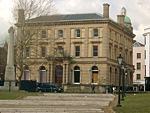  Established in 1786 by Samuel Milford and Richard Hall Clark, the City Bank's first premises were on the corner of Bear Street, near the Deanery. Milford was a successful serge and woollen merchant. The partners contributed £15,000 each to the business, who then engaged "a steadyclerk of... undoubted character". In 1793 the bank moved to a newly built banking hall close to Broadgate. The bank merged with the Devon and Cornwall Bank and rebuilt its premises in 1876, into what you see today. Established in 1786 by Samuel Milford and Richard Hall Clark, the City Bank's first premises were on the corner of Bear Street, near the Deanery. Milford was a successful serge and woollen merchant. The partners contributed £15,000 each to the business, who then engaged "a steadyclerk of... undoubted character". In 1793 the bank moved to a newly built banking hall close to Broadgate. The bank merged with the Devon and Cornwall Bank and rebuilt its premises in 1876, into what you see today.
|
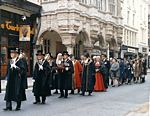  When Exeter had its own Crown Court at the Guildhall, the Assizes was opened after a procession to the Cathedral fro a service. Michael McGahey became the last officiating Sheriff of Exeter, present at the last City Assize and Quarter Sessions in the Guildhall in 1972. Photo right shows the 1972 Assizes procession leaving the Guildhall. When Exeter had its own Crown Court at the Guildhall, the Assizes was opened after a procession to the Cathedral fro a service. Michael McGahey became the last officiating Sheriff of Exeter, present at the last City Assize and Quarter Sessions in the Guildhall in 1972. Photo right shows the 1972 Assizes procession leaving the Guildhall.
|
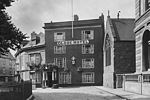 The Globe Tavern was noted as a centre for cockfighting in the 18th century. Local citizens used to meet there for the annual 5th November celebration of the attempted blowing up of Parliament by Guido Fawkes. Its rooms were also used by Britain's first bee keeping association for their meetings between 1797 and 1807. The Globe was also important to Freemasonry in Devon when it became the meeting place in 1774 of the Provincial Grand Lodge of Devon Freemasons, founded by Sir Charles Bampfylde who was the Master of the Lodge. The Globe Tavern was noted as a centre for cockfighting in the 18th century. Local citizens used to meet there for the annual 5th November celebration of the attempted blowing up of Parliament by Guido Fawkes. Its rooms were also used by Britain's first bee keeping association for their meetings between 1797 and 1807. The Globe was also important to Freemasonry in Devon when it became the meeting place in 1774 of the Provincial Grand Lodge of Devon Freemasons, founded by Sir Charles Bampfylde who was the Master of the Lodge.
|
 A
little further east can be found Broadgate,
the, ancient grand, entrance to Cathedral Yard. Now a short street, the
left side was the City Bank and the
right hand side has Pizza Express, remembered fondly by many as Tinleys Tea Shop. Charlotte Treadwin,
Queen Victoria's favourite lace maker, had her first lace showroom on
the site of Pizza Express. A
little further east can be found Broadgate,
the, ancient grand, entrance to Cathedral Yard. Now a short street, the
left side was the City Bank and the
right hand side has Pizza Express, remembered fondly by many as Tinleys Tea Shop. Charlotte Treadwin,
Queen Victoria's favourite lace maker, had her first lace showroom on
the site of Pizza Express.
|
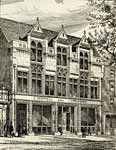 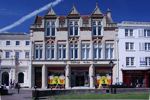 This
is the original architects drawing for Wippells,
dating from the 1880's. Joseph Wippell Jnr., established his drapery business in 1834. The company became the leading supplier of ecclesiastical drapery in the country, and now trade from premises in St Thomas. The building now houses Edinburgh Wool. Illustration
courtesy of Dick Passmore This
is the original architects drawing for Wippells,
dating from the 1880's. Joseph Wippell Jnr., established his drapery business in 1834. The company became the leading supplier of ecclesiastical drapery in the country, and now trade from premises in St Thomas. The building now houses Edinburgh Wool. Illustration
courtesy of Dick Passmore
|
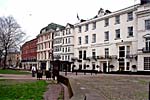 Built by William Mackworth Praed in 1769 as the Assembly Rooms, the Royal Clarence Hotel is credited as the first hotel in England. On 7th September 1770, an advert appeared using the word hôtel for the first time published by the landlord, the Frenchman, Pierre Berlon. It is now part owned by Michael
Caine, who is responsible for the high quality food in the restaurant.
Alongside, in the old Dellers Cafe and
Exeter Bank building, is Caine's Abode. Built by William Mackworth Praed in 1769 as the Assembly Rooms, the Royal Clarence Hotel is credited as the first hotel in England. On 7th September 1770, an advert appeared using the word hôtel for the first time published by the landlord, the Frenchman, Pierre Berlon. It is now part owned by Michael
Caine, who is responsible for the high quality food in the restaurant.
Alongside, in the old Dellers Cafe and
Exeter Bank building, is Caine's Abode.
|
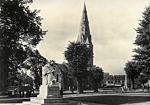  Richard Hooker was born in Heavitree in 1554 and educated at Exeter Grammar School. The statue, unveiled in 1907, is of, is carved out of white 'pentilicon' marble, by Alfred Drury RA (1856-1944), at a cost of a thousand guineas. Richard Hooker was born in Heavitree in 1554 and educated at Exeter Grammar School. The statue, unveiled in 1907, is of, is carved out of white 'pentilicon' marble, by Alfred Drury RA (1856-1944), at a cost of a thousand guineas.
|
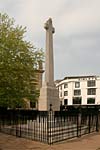  The Devon War Memorial was designed by the architect Sir Edwin Lutyens, and made out of a single piece of Haytor granite. The Haytor quarry, which supplied the granite for London Bridge (the one in Arizona!), was reopened in 1919 especially to extract the stone for the memorial. It was
unveiled in 1921 by the Prince of Wales. The Devon War Memorial was designed by the architect Sir Edwin Lutyens, and made out of a single piece of Haytor granite. The Haytor quarry, which supplied the granite for London Bridge (the one in Arizona!), was reopened in 1919 especially to extract the stone for the memorial. It was
unveiled in 1921 by the Prince of Wales. |
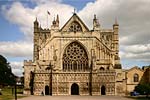 The famous West Window of
the Cathedral faces Broadgate. Bishop John Grandisson added the West Front by 1342, a beautiful facade which at the time was painted in bright colours. Just imagine all those saints, kings and biblical figures painted in a rich rainbow of colour - it would have been stunning! The famous West Window of
the Cathedral faces Broadgate. Bishop John Grandisson added the West Front by 1342, a beautiful facade which at the time was painted in bright colours. Just imagine all those saints, kings and biblical figures painted in a rich rainbow of colour - it would have been stunning!
|
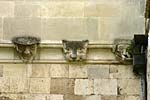 Last,
take a look for Butch the
smoking dog grotesque. It was carved by Peter Dare, when they were replacing the badly weathered grotesques on that side. It is a dog called Butch that frequented a pub in Exmouth in the 70's and 80's and enjoyed a pipe of tobacco along with its owner. He can be found on the north wall of the
Cathedral, facing the Devon & Exeter Institution. Last,
take a look for Butch the
smoking dog grotesque. It was carved by Peter Dare, when they were replacing the badly weathered grotesques on that side. It is a dog called Butch that frequented a pub in Exmouth in the 70's and 80's and enjoyed a pipe of tobacco along with its owner. He can be found on the north wall of the
Cathedral, facing the Devon & Exeter Institution. |

